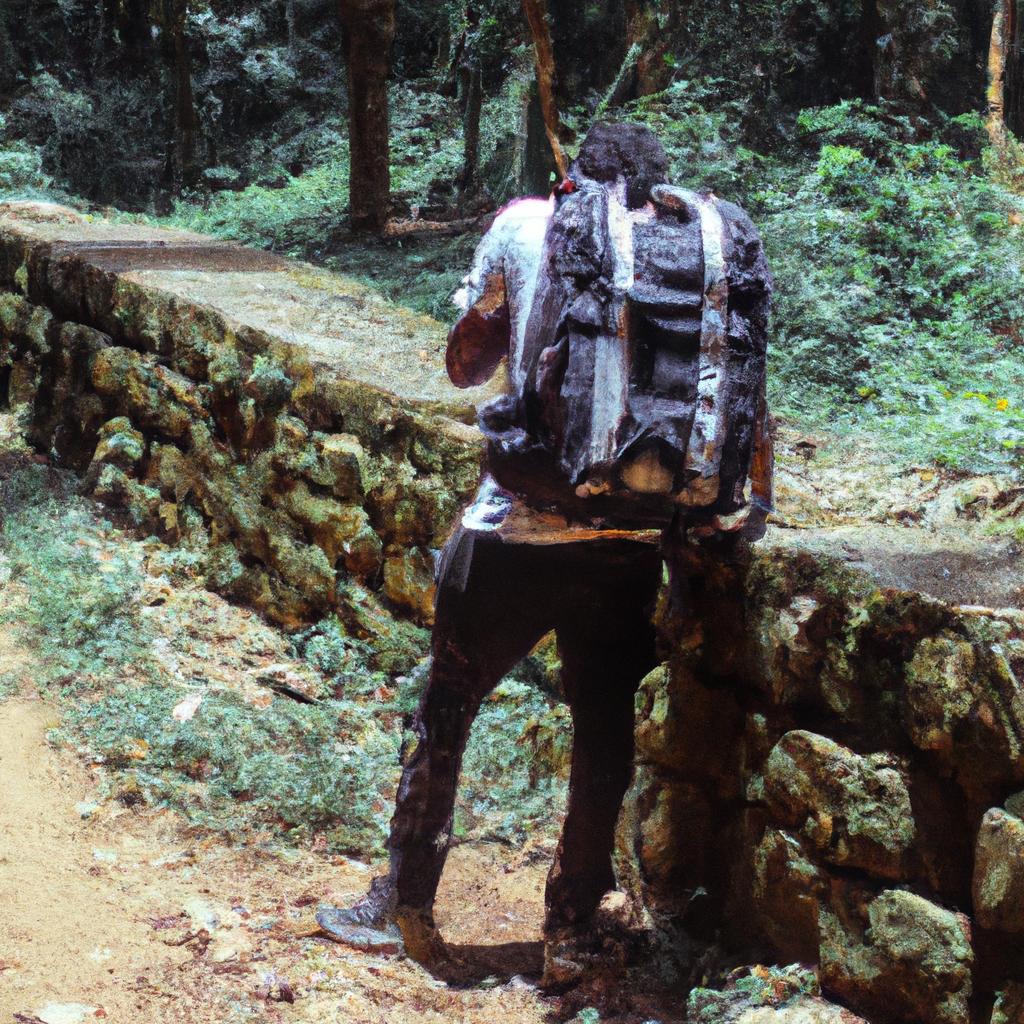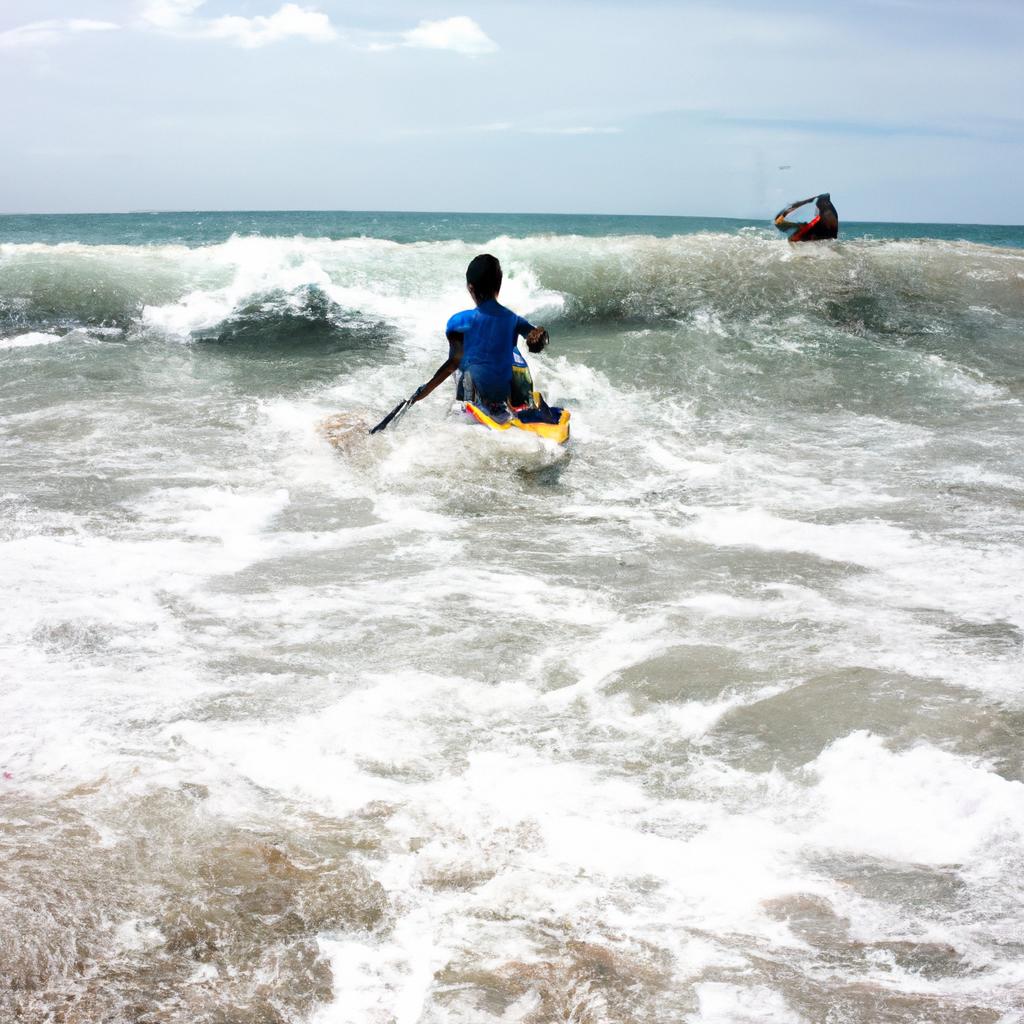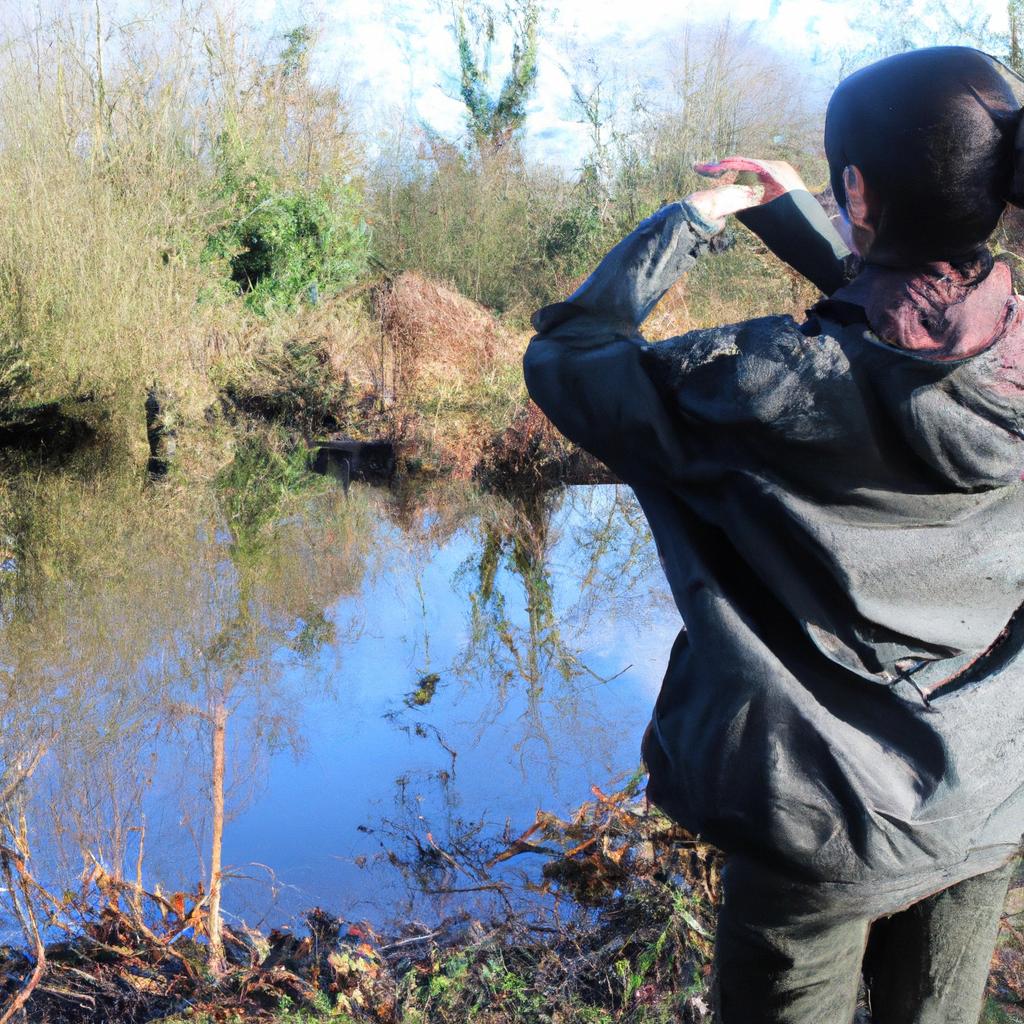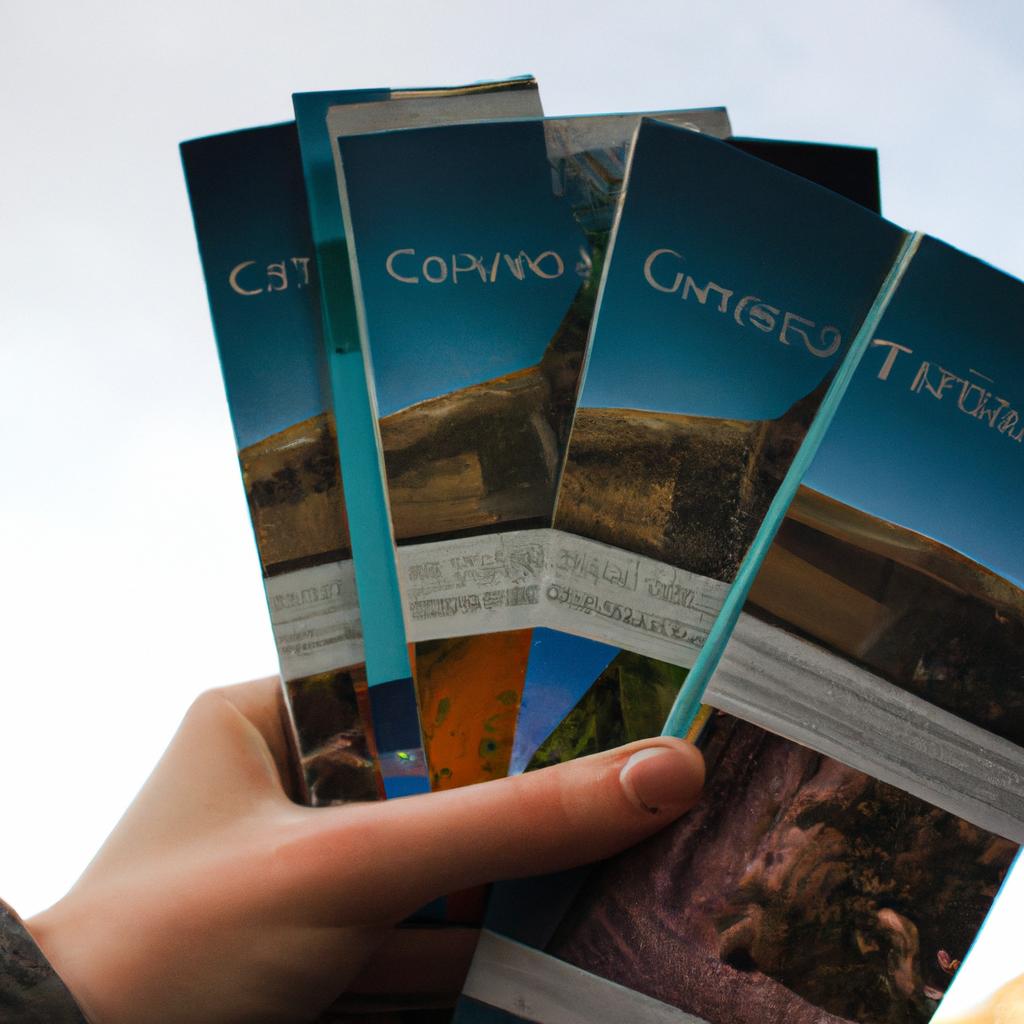Wildlife encounters have become an increasingly popular form of adventure travel in recent years. The allure of exploring natural habitats and encountering diverse species firsthand has captivated the imagination of many adventurous travelers. This article explores the concept of wildlife encounters as a form of recreation, examining their significance, benefits, and potential impacts on both tourists and wildlife.
One compelling example that exemplifies the appeal of wildlife encounters is the case study of John, an avid traveler seeking unforgettable experiences. Having heard tales of thrilling interactions with wild animals in Africa, John embarks on a safari expedition to witness these wonders himself. During his trip, he observes majestic elephants roaming freely across vast savannahs, catches glimpses of elusive big cats prowling through dense vegetation, and even witnesses a heart-stopping standoff between a pride of lions and a herd of buffalo. These exhilarating moments leave John awestruck by nature’s beauty and inspire him to advocate for conservation efforts upon returning home.
The surge in interest towards such adventures can be attributed to various factors. Firstly, wildlife encounters offer individuals the opportunity to disconnect from modern-day distractions and reconnect with the natural world. In an era dominated by technology-dependent lifestyles, this immersion in pristine environments serves as a refreshing escape from daily routines. Furthermore, these wildlife encounters provide a sense of wonder and awe, allowing individuals to witness firsthand the incredible diversity and beauty of Earth’s creatures. This can be a transformative experience that fosters a deeper appreciation for the natural world and sparks a desire to protect and conserve it.
In addition to the personal benefits, wildlife encounters also have the potential to contribute positively to local communities and conservation efforts. Many wildlife tourism operators work closely with local communities, providing employment opportunities and economic incentives for protecting habitats and wildlife populations. By supporting responsible tourism practices, travelers can help promote sustainable development in these areas.
However, it is important to recognize that wildlife encounters also come with potential risks and impacts. Irresponsible tourism practices such as overcrowding, habitat destruction, and disturbance of animals can have negative consequences on both wildlife populations and their habitats. It is crucial for travelers to choose reputable tour operators who prioritize ethical guidelines and adhere to strict regulations to minimize these impacts.
To ensure a positive experience while minimizing harm, it is essential for travelers engaging in wildlife encounters to follow certain guidelines. These include maintaining a respectful distance from animals, avoiding any actions that may disrupt their natural behavior or habitat, refraining from feeding or touching wild animals, and following the guidance of trained guides or rangers.
In conclusion, wildlife encounters offer unique opportunities for adventure travel enthusiasts to connect with nature on a profound level. When approached responsibly, they can provide unforgettable experiences while contributing positively to conservation efforts. By understanding the significance, benefits, and potential impacts of wildlife encounters, travelers can make informed choices that support sustainable tourism practices and help preserve our planet’s precious biodiversity.
Choosing the Right Destination
When planning an adventure travel experience centered around wildlife encounters, selecting the right destination is crucial. The choice of destination will determine the range of species and ecosystems that can be explored, as well as the overall quality of the experience. To illustrate this point, let us consider a hypothetical case study: a nature enthusiast named Sarah who desires to witness the magnificent migration of wildebeests in Africa.
Firstly, it is important for Sarah to research destinations known for hosting wildebeest migrations. One such example is Serengeti National Park in Tanzania, which offers a unique opportunity to witness this awe-inspiring phenomenon up close. By choosing this specific location, Sarah ensures she maximizes her chances of observing thousands of wildebeests crossing vast plains and encountering predators along their journey.
To assist travelers like Sarah in making informed decisions about wildlife travel destinations, here are some key factors to consider:
- Biodiversity: Choose a destination with a rich variety of flora and fauna to explore.
- Conservation efforts: Opt for places that prioritize environmental protection and sustainable tourism practices.
- Accessibility: Consider transportation options and ease of reaching remote areas where wildlife thrives.
- Local expertise: Seek out locations offering knowledgeable guides or experts familiar with local ecosystems.
Table 1 provides a comparison between two possible safari destinations – Serengeti National Park in Tanzania and Maasai Mara National Reserve in Kenya – highlighting their respective features:
| Feature | Serengeti National Park | Maasai Mara National Reserve |
|---|---|---|
| Wildlife diversity | High | Moderate |
| Wildebeest migration | Yes | Yes |
| Scenic landscapes | Vast plains | Rolling grasslands |
| Cultural experiences available | Limited | Extensive |
As shown above, each location has its own unique attributes that may appeal differently to various travelers. The decision ultimately depends on personal preferences, budget considerations, and specific wildlife interests.
In selecting the right destination for a wildlife adventure, careful deliberation is necessary to ensure an unforgettable experience. By considering factors such as biodiversity, conservation efforts, accessibility, and local expertise, adventurers like Sarah can make informed decisions that align with their goals and expectations. With this in mind, let us now explore the next step: preparing for wildlife encounters.
[Transition sentence into subsequent section about “Preparing for Wildlife Encounters”] As we delve into the preparations required before embarking on a wildlife expedition, it is essential to consider practical aspects such as safety measures and equipment needed.
Preparing for Wildlife Encounters
Imagine embarking on an adventure travel expedition to witness the wonders of wildlife in their natural habitats. Picture yourself standing at the edge of a dense forest, eagerly waiting for a glimpse of elusive creatures or setting sail across pristine waters, scanning the horizon for marine life. The world is teeming with remarkable destinations that offer unparalleled opportunities to encounter diverse and awe-inspiring wildlife.
When choosing the right destination for your wildlife adventures, several factors should be considered. Firstly, take into account the specific species you wish to observe. For instance, if you have a fascination with big cats like lions and leopards, then planning a safari in Africa would be ideal. On the other hand, if swimming alongside majestic whale sharks or exploring vibrant coral reefs is what captivates you, then diving spots in Australia’s Great Barrier Reef may fulfill your desires.
Secondly, consider the accessibility and infrastructure of potential destinations. Some remote locations might require special permits or arrangements, while others boast well-established ecotourism facilities. Researching these aspects beforehand will help ensure a smooth and enjoyable journey.
Lastly, think about your own comfort level and preferences regarding accommodations and activities. Are you seeking luxurious lodges nestled deep within nature reserves? Or perhaps camping under starlit skies surrounded by wilderness appeals more to your spirit of adventure? Tailoring your choice based on such considerations will greatly enhance your overall experience.
To further ignite your imagination and inspire wanderlust, here are some captivating examples of wildlife encounters from around the globe:
- Witness thousands of wildebeest crossing crocodile-infested rivers during Tanzania’s Great Migration.
- Observe playful orangutans swinging through trees in Borneo’s lush rainforests.
- Dive into crystal-clear waters off Mexico’s coast to swim alongside graceful sea turtles.
- Marvel at Antarctica’s vast penguin colonies as they waddle along icy shores.
Let these extraordinary experiences beckon you as you explore the possibilities that await in captivating wildlife destinations. To aid your decision-making process, consult the table below showcasing some of the world’s most renowned locations and their notable wildlife attractions.
| Destination | Notable Wildlife Attractions |
|---|---|
| South Africa | Big Five game drives |
| Costa Rica | Howler monkeys and colorful birds |
| Galapagos Islands | Giant tortoises and marine iguanas |
| Canadian Rockies | Grizzly bears and elk |
As you delve into planning your adventure, remember to stay tuned for our next section which will provide crucial safety tips for wildlife encounters. By following these guidelines, you can ensure a responsible approach towards interacting with nature while safeguarding both yourself and the magnificent creatures you encounter.
Next Section: Safety Tips for Wildlife Encounters
Safety Tips for Wildlife encounters
Imagine this scenario: You are embarking on a thrilling adventure travel expedition deep into the heart of a dense rainforest. As you trek through the untamed wilderness, your senses heighten with anticipation, knowing that at any moment you could encounter magnificent creatures in their natural habitats. However, it is essential to be well-prepared for these wildlife encounters to ensure both your safety and the preservation of these delicate ecosystems.
To effectively prepare for wildlife encounters, consider the following guidelines:
-
Research and educate yourself about the local flora and fauna:
- Familiarize yourself with the native species found in the area.
- Learn about their behavioral patterns and potential risks associated with each species.
- Understand any protected areas or regulations governing wildlife interaction.
-
Pack appropriate gear and equipment:
- Carry binoculars or a camera with telephoto lenses to observe animals from a safe distance.
- Bring sturdy footwear suitable for various terrains encountered during your journey.
- Have insect repellent and protective clothing to guard against bites or stings.
-
Know how to respond when encountering wildlife:
- Maintain a respectful distance between yourself and wild animals; never approach them too closely.
- Observe silently without causing disturbances or altering their behavior.
- Be aware of signs indicating stress or aggression in animals and adjust your actions accordingly.
-
Engage in responsible tourism practices:
- Choose reputable tour operators committed to protecting wildlife and preserving habitats.
- Support conservation efforts by adhering to ethical guidelines such as not feeding or touching animals.
- Respect local communities’ traditions regarding wildlife interactions.
By adhering to these guiding principles, you can embark on an unforgettable adventure while minimizing negative impacts on ecosystems and ensuring your own safety.
Transitioning seamlessly into our next topic, let us now explore best practices for capturing those incredible moments through wildlife photography.
Best Practices for Wildlife Photography
Safety Tips for Wildlife Encounters
In the previous section, we discussed important safety tips to keep in mind when encountering wildlife. Now, let’s explore some best practices for capturing those incredible moments through photography while ensuring the well-being of both the animals and ourselves.
Imagine you are hiking through a dense forest, camera in hand, when suddenly you stumble upon a family of deer grazing peacefully nearby. To document this enchanting scene without causing any harm or distress to the animals, consider these guidelines:
- Maintain a respectful distance: Getting too close can disrupt their natural behavior and potentially pose a threat. Use zoom lenses or telephoto settings on your camera to capture intimate shots from afar.
- Avoid flash photography: Flash can startle and disorientate animals, leading to unnecessary stress. Opt for natural lighting whenever possible.
- Be patient: Animals may not always cooperate with our desire for that perfect shot. Respect their boundaries and wait for an opportunity when they feel comfortable enough to showcase their true nature.
- Leave no trace: Always follow ethical principles by refraining from interfering with the environment or disturbing animal habitats. Preserve wilderness areas as you found them so others can enjoy them too.
To further illustrate how responsible wildlife photography can benefit both humans and animals alike, here is a case study showcasing positive outcomes:
| Case Study | Impact |
|---|---|
| A renowned photographer captures stunning images of endangered marine life during scuba diving expeditions | – Raises awareness about threatened species- Inspires conservation efforts- Promotes eco-tourism destinations- Contributes to scientific research |
By adhering to these best practices, we ensure that our encounters with wildlife go beyond mere documentation – they become meaningful experiences that foster appreciation and understanding.
Transitioning seamlessly into the subsequent section about Responsible Wildlife Tourism
Responsible Wildlife Tourism
Transitioning from the best practices for wildlife photography, it is crucial to delve into responsible wildlife tourism. To illustrate the importance of responsible behavior, let’s consider a hypothetical scenario. Imagine a group of tourists visiting an elephant sanctuary in Southeast Asia. They are excited to interact with these majestic creatures and capture memorable photos. However, some members of the group disregard guidelines provided by the sanctuary staff and approach too closely, causing distress to the elephants.
Responsible wildlife tourism entails adhering to ethical standards when encountering animals in their natural habitats or sanctuaries. By practicing responsible behavior, not only can visitors ensure the well-being of wildlife but also contribute positively to conservation efforts. Here are a few key principles that should guide every tourist engaging in wildlife encounters:
- Respect animal welfare: Prioritize the safety, comfort, and freedom of animals over personal desires.
- Follow established guidelines: Abide by rules set forth by tour operators, guides, and protected areas to minimize disturbance to wildlife.
- Maintain distance: Keep a safe distance from animals to avoid stress or altering their natural behaviors.
- Educate yourself: Learn about local flora and fauna before embarking on your adventure to better understand and appreciate them.
To highlight the significance of responsible tourism further, we can examine its potential impact through a comparative analysis:
| Irresponsible Wildlife Tourism | Responsible Wildlife Tourism | |
|---|---|---|
| Animal Welfare | Neglected | Prioritized |
| Environmental | Degradation | Preservation |
| Impact | Negative | Positive |
As seen above, irresponsible practices lead to negative consequences for both wildlife and their surroundings. Conversely, embracing responsible behavior creates positive outcomes such as improved animal welfare and environmental preservation.
By adopting responsible habits during wildlife encounters, travelers become advocates for conservation without compromising their desire for adventure and exploration. This symbiotic relationship between sustainable tourism and wildlife preservation will be further explored in the subsequent section on the impact of wildlife encounters on conservation efforts.
Impact of Wildlife Encounters on Conservation Efforts
Responsible Wildlife Tourism plays a crucial role in ensuring the preservation and conservation of our planet’s diverse ecosystems. However, it is important to understand the potential impact of wildlife encounters on these conservation efforts. By examining case studies and considering various perspectives, we can gain insight into how such encounters influence both local communities and the overall biodiversity.
One example that highlights the complexities of wildlife tourism is the interaction between tourists and sea turtles in coastal regions. In certain destinations, tourists have the opportunity to witness sea turtle nesting or participate in hatchling releases. While this may appear harmless at first glance, there are significant considerations to be made regarding its long-term ecological implications. Increased human presence during nesting periods may disrupt natural behavior patterns, leading to stress for these vulnerable creatures. Additionally, improperly managed tours could result in habitat degradation or unintentional harm to nests.
To better comprehend the impact of wildlife encounters on conservation efforts, let us explore some key factors that need careful consideration:
- Ecological disruption: The influx of visitors can disturb animal behaviors, breeding cycles, feeding patterns, and migration routes.
- Biosecurity risks: Unregulated tourist activities might introduce invasive species or diseases that pose threats to native flora and fauna.
- Local community engagement: Engaging local communities as active participants in wildlife tourism initiatives fosters their commitment towards environmental protection.
- Economic viability: Sustainable financial models should be established to ensure ongoing funding for conservation projects while providing economic benefits for local communities.
Table 1 below provides an overview of some common challenges faced by responsible wildlife tourism operators:
| Challenges | Examples |
|---|---|
| Habitat destruction | Unsustainable infrastructure |
| Overcrowding | Insufficient visitor management |
| Lack of education | Limited awareness campaigns |
| Animal exploitation | Unauthorized petting or handling |
It becomes evident from such examples and analyses that striking a balance between offering immersive experiences for tourists while safeguarding fragile ecosystems is crucial. Responsible wildlife tourism should prioritize the well-being of both animals and their habitats, as well as actively engage in conservation efforts.
By implementing effective management strategies that include visitor education, habitat restoration projects, and strict regulations on tour operators, it becomes possible to mitigate negative impacts while still allowing for meaningful encounters with wildlife. The collaboration between scientists, local communities, governments, and tourists themselves plays a pivotal role in ensuring that these experiences contribute positively to wildlife conservation in the long run.
In summary, responsible wildlife tourism necessitates careful consideration of its impact on conservation efforts. By incorporating sustainable practices into tourist activities and engaging local communities as active stakeholders, we can strike a balance between providing exciting encounters for visitors and preserving our planet’s biodiversity. It is imperative that all parties involved work together towards promoting environmentally conscious travel practices to protect fragile ecosystems for generations to come.











